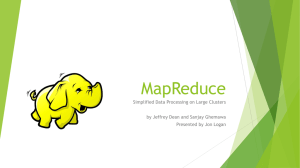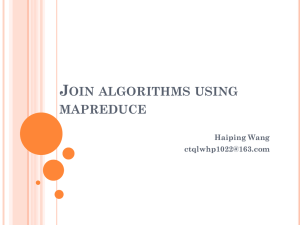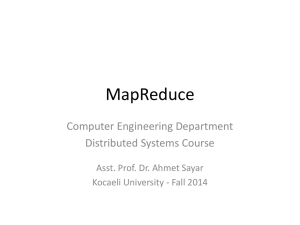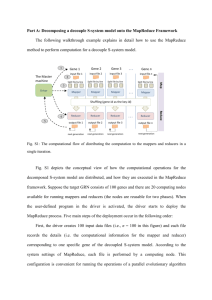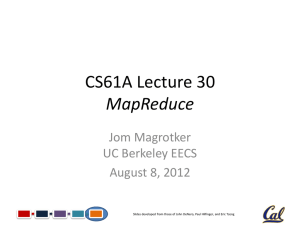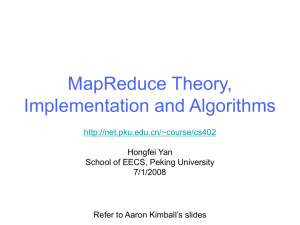PowerPoint
advertisement
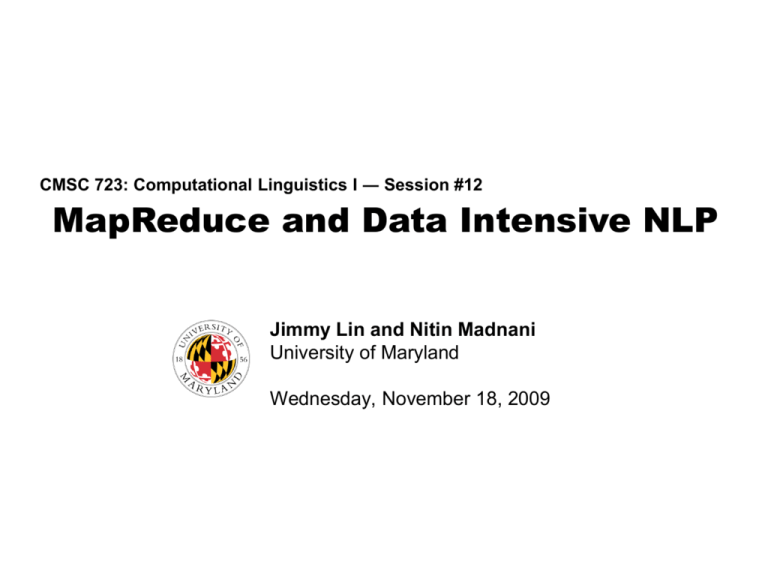
CMSC 723: Computational Linguistics I ― Session #12
MapReduce and Data Intensive NLP
Jimmy Lin and Nitin Madnani
University of Maryland
Wednesday, November 18, 2009
Three Pillars of Statistical NLP
Algorithms and models
Features
Data
Why big data?
Fundamental fact of the real world
Systems improve with more data
How much data?
Google processes 20 PB a day (2008)
Wayback Machine has 3 PB + 100 TB/month (3/2009)
Facebook has 2.5 PB of user data + 15 TB/day (4/2009)
eBay has 6.5 PB of user data + 50 TB/day (5/2009)
CERN’s LHC will generate 15 PB a year (??)
640K ought to be
enough for anybody.
No data like more data!
s/knowledge/data/g;
How do we get here if we’re not Google?
(Banko and Brill, ACL 2001)
(Brants et al., EMNLP 2007)
How do we scale up?
Divide and Conquer
“Work”
Partition
w1
w2
w3
“worker”
“worker”
“worker”
r1
r2
r3
“Result”
Combine
It’s a bit more complex…
Fundamental issues
Different programming models
Message Passing
Shared Memory
P1 P2 P3 P4 P5
P1 P2 P3 P4 P5
Memory
scheduling, data distribution, synchronization,
inter-process communication, robustness, fault
tolerance, …
Architectural issues
Flynn’s taxonomy (SIMD, MIMD, etc.),
network typology, bisection bandwidth
UMA vs. NUMA, cache coherence
Different programming constructs
mutexes, conditional variables, barriers, …
masters/slaves, producers/consumers, work queues, …
Common problems
livelock, deadlock, data starvation, priority inversion…
dining philosophers, sleeping barbers, cigarette smokers, …
The reality: programmer shoulders the burden
of managing concurrency…
Source: Ricardo Guimarães Herrmann
Source: MIT Open Courseware
Source: MIT Open Courseware
Source: Harper’s (Feb, 2008)
MapReduce
Typical Large-Data Problem
Iterate over a large number of records
Extract something of interest from each
Shuffle and sort intermediate results
Aggregate intermediate results
Generate final output
Key idea: provide a functional abstraction for
these two operations
(Dean and Ghemawat, OSDI 2004)
Roots in Functional Programming
Map
f
f
f
f
f
Fold
g
g
g
g
g
MapReduce
Programmers specify two functions:
map (k, v) → <k’, v’>*
reduce (k’, v’) → <k’, v’>*
All values with the same key are reduced together
The execution framework handles everything else…
k1 v1
k2 v2
map
a 1
k3 v3
k4 v4
map
b 2
c 3
k5 v5
k6 v6
map
c 6
a 5
map
c 2
b 7
c 8
Shuffle and Sort: aggregate values by keys
a
1 5
b
2 7
c
2 3 6 8
reduce
reduce
reduce
r1 s1
r2 s2
r3 s3
MapReduce
Programmers specify two functions:
map (k, v) → <k’, v’>*
reduce (k’, v’) → <k’, v’>*
All values with the same key are reduced together
The execution framework handles everything else…
Not quite…usually, programmers also specify:
partition (k’, number of partitions) → partition for k’
Often a simple hash of the key, e.g., hash(k’) mod n
Divides up key space for parallel reduce operations
combine (k’, v’) → <k’, v’>*
Mini-reducers that run in memory after the map phase
Used as an optimization to reduce network traffic
k1 v1
k2 v2
map
a 1
k4 v4
map
b 2
c 3
combine
a 1
k3 v3
c 6
a 5
map
c 2
b 7
combine
c 9
partition
k6 v6
map
combine
b 2
k5 v5
a 5
partition
c 8
combine
c 2
b 7
partition
c 8
partition
Shuffle and Sort: aggregate values by keys
a
1 5
b
2 7
c
2 3 6 8
reduce
reduce
reduce
r1 s1
r2 s2
r3 s3
MapReduce “Runtime”
Handles scheduling
Handles “data distribution”
Gathers, sorts, and shuffles intermediate data
Handles errors and faults
Moves processes to data
Handles synchronization
Assigns workers to map and reduce tasks
Detects worker failures and restarts
Everything happens on top of a distributed FS (later)
“Hello World”: Word Count
Map(String docid, String text):
for each word w in text:
Emit(w, 1);
Reduce(String term, Iterator<Int> values):
int sum = 0;
for each v in values:
sum += v;
Emit(term, value);
MapReduce can refer to…
The programming model
The execution framework (aka “runtime”)
The specific implementation
Usage is usually clear from context!
MapReduce Implementations
Google has a proprietary implementation in C++
Hadoop is an open-source implementation in Java
Bindings in Java, Python
Project led by Yahoo, used in production
Rapidly expanding software ecosystem
Lots of custom research implementations
For GPUs, cell processors, etc.
User
Program
(1) fork
(1) fork
(1) fork
Master
(2) assign map
(2) assign reduce
worker
split 0
split 1
split 2
split 3
(5) remote read
(3) read
worker
worker
(6) write
output
file 0
(4) local write
split 4
worker
output
file 1
worker
Input
files
Map
phase
Redrawn from (Dean and Ghemawat, OSDI 2004)
Intermediate files
(on local disk)
Reduce
phase
Output
files
How do we get data to the workers?
NAS
SAN
Compute Nodes
What’s the problem here?
Distributed File System
Don’t move data to workers… move workers to the data!
Why?
Store data on the local disks of nodes in the cluster
Start up the workers on the node that has the data local
Not enough RAM to hold all the data in memory
Disk access is slow, but disk throughput is reasonable
A distributed file system is the answer
GFS (Google File System)
HDFS for Hadoop (= GFS clone)
GFS: Assumptions
Commodity hardware over “exotic” hardware
Scale out, not up
High component failure rates
Inexpensive commodity components fail all the time
“Modest” number of huge files
Files are write-once, mostly appended to
Perhaps concurrently
Large streaming reads over random access
High sustained throughput over low latency
GFS slides adapted from material by (Ghemawat et al., SOSP 2003)
GFS: Design Decisions
Files stored as chunks
Reliability through replication
Simple centralized management
No data caching
Each chunk replicated across 3+ chunkservers
Single master to coordinate access, keep metadata
Fixed size (64MB)
Little benefit due to large datasets, streaming reads
Simplify the API
Push some of the issues onto the client
HDFS = GFS clone (same basic ideas)
HDFS Architecture
HDFS namenode
Application
(file name, block id)
HDFS Client
/foo/bar
File namespace
block 3df2
(block id, block location)
instructions to datanode
(block id, byte range)
block data
datanode state
HDFS datanode
HDFS datanode
Linux file system
Linux file system
…
Adapted from (Ghemawat et al., SOSP 2003)
…
Master’s Responsibilities
Metadata storage
Namespace management/locking
Periodic communication with the datanodes
Chunk creation, re-replication, rebalancing
Garbage collection
MapReduce Algorithm Design
Managing Dependencies
Remember: Mappers run in isolation
You have no idea in what order the mappers run
You have no idea on what node the mappers run
You have no idea when each mapper finishes
Tools for synchronization:
Ability to hold state in reducer across multiple key-value pairs
Sorting function for keys
Partitioner
Cleverly-constructed data structures
Slides in this section adapted from work reported in (Lin, EMNLP 2008)
Motivating Example
Term co-occurrence matrix for a text collection
M = N x N matrix (N = vocabulary size)
Mij: number of times i and j co-occur in some context
(for concreteness, let’s say context = sentence)
Why?
Distributional profiles as a way of measuring semantic distance
Semantic distance useful for many language processing tasks
MapReduce: Large Counting Problems
Term co-occurrence matrix for a text collection
= specific instance of a large counting problem
A large event space (number of terms)
A large number of observations (the collection itself)
Goal: keep track of interesting statistics about the events
Basic approach
Mappers generate partial counts
Reducers aggregate partial counts
How do we aggregate partial counts efficiently?
First Try: “Pairs”
Each mapper takes a sentence:
Generate all co-occurring term pairs
For all pairs, emit (a, b) → count
Reducers sums up counts associated with these pairs
Use combiners!
“Pairs” Analysis
Advantages
Easy to implement, easy to understand
Disadvantages
Lots of pairs to sort and shuffle around (upper bound?)
Another Try: “Stripes”
Idea: group together pairs into an associative array
(a, b) → 1
(a, c) → 2
(a, d) → 5
(a, e) → 3
(a, f) → 2
Each mapper takes a sentence:
a → { b: 1, c: 2, d: 5, e: 3, f: 2 }
Generate all co-occurring term pairs
For each term, emit a → { b: countb, c: countc, d: countd … }
Reducers perform element-wise sum of associative arrays
+
a → { b: 1,
d: 5, e: 3 }
a → { b: 1, c: 2, d: 2,
f: 2 }
a → { b: 2, c: 2, d: 7, e: 3, f: 2 }
“Stripes” Analysis
Advantages
Far less sorting and shuffling of key-value pairs
Can make better use of combiners
Disadvantages
More difficult to implement
Underlying object is more heavyweight
Fundamental limitation in terms of size of event space
Cluster size: 38 cores
Data Source: Associated Press Worldstream (APW) of the English Gigaword Corpus (v3),
which contains 2.27 million documents (1.8 GB compressed, 5.7 GB uncompressed)
Conditional Probabilities
How do we estimate conditional probabilities from counts?
count ( A, B)
P( B | A)
count ( A)
count ( A, B)
count ( A, B' )
B'
Why do we want to do this?
How do we do this with MapReduce?
P(B|A): “Stripes”
a → {b1:3, b2 :12, b3 :7, b4 :1, … }
Easy!
One pass to compute (a, *)
Another pass to directly compute P(B|A)
P(B|A): “Pairs”
(a, *) → 32
Reducer holds this value in memory
(a, b1) → 3
(a, b2) → 12
(a, b3) → 7
(a, b4) → 1
…
(a, b1) → 3 / 32
(a, b2) → 12 / 32
(a, b3) → 7 / 32
(a, b4) → 1 / 32
…
For this to work:
Must emit extra (a, *) for every bn in mapper
Must make sure all a’s get sent to same reducer (use partitioner)
Must make sure (a, *) comes first (define sort order)
Must hold state in reducer across different key-value pairs
Synchronization in Hadoop
Approach 1: turn synchronization into an ordering problem
Sort keys into correct order of computation
Partition key space so that each reducer gets the appropriate set
of partial results
Hold state in reducer across multiple key-value pairs to perform
computation
Illustrated by the “pairs” approach
Approach 2: construct data structures that “bring the
pieces together”
Each reducer receives all the data it needs to complete the
computation
Illustrated by the “stripes” approach
Issues and Tradeoffs
Number of key-value pairs
Size of each key-value pair
Object creation overhead
Time for sorting and shuffling pairs across the network
De/serialization overhead
Combiners make a big difference!
RAM vs. disk vs. network
Arrange data to maximize opportunities to aggregate partial results
Case Study: LMs with MR
Language Modeling Recap
Interpolation: Consult all models at the same time to
compute an interpolated probability estimate.
Backoff: Consult the highest order model first and backoff
to lower order model only if there are no higher order
counts.
Interpolated Kneser Ney (state-of-the-art)
Use absolute discounting to save some probability mass for lower
order models.
Use a novel form of lower order models (count unique single word
contexts instead of occurrences)
Combine models into a true probability model using interpolation
Questions for today
Can we efficiently train an IKN LM with terabytes of data?
Does it really matter?
Using MapReduce to Train IKN
Step 0: Count words [MR]
Step 0.5: Assign IDs to words [vocabulary generation]
(more frequent → smaller IDs)
Step 1: Compute n-gram counts [MR]
Step 2: Compute lower order context counts [MR]
Step 3: Compute unsmoothed probabilities and
interpolation weights [MR]
Step 4: Compute interpolated probabilities [MR]
[MR] = MapReduce job
Steps 0 & 0.5
Step 0
Step 0.5
Reducer
Output
Mapper Output
Reducer Input
Mapper Input
Steps 1-4
Step 1
Step 2
Step 3
Step 4
Input Key
DocID
n-grams
“a b c”
“a b c”
“a b”
Input Value
Document
Ctotal(“a b c”)
CKN(“a b c”)
_Step 3 Output_
Intermediate
Key
n-grams
“a b c”
“a b c”
“a b” (history)
“c b a”
Intermediate
Value
Cdoc(“a b c”)
C’KN(“a b c”)
(“c”, CKN(“a b c”))
(P’(“a b c”), λ(“a b”))
Partitioning
“a b c”
“a b c”
“a b”
“c b”
Output Value
Ctotal(“a b c”)
CKN(“a b c”)
(“c”, P’(“a b c”),
λ(“a b”))
(PKN(“a b c”),
λ(“a b”))
Count
n-grams
Count
contexts
Compute unsmoothed
probs AND interp. weights
All output keys are always the same as the intermediate keys
I only show trigrams here but the steps operate on bigrams and unigrams as well
Compute
Interp. probs
Mapper Input
Steps 1-4
Step 1
Step 2
Step 3
Step 4
Input Key
DocID
n-grams
“a b c”
“a b c”
“a b”
Input Value
Document
Ctotal(“a b c”)
CKN(“a b c”)
_Step 3 Output_
Mapper Output
Reducer Input
Details are not important!
Intermediate
Key
Intermediate
Value
Partitioning
n-grams
“a to
b c”train IKN (expensive)!
“a b” (history)
5 MR jobs
“a b c”
Cdoc(“a b c”)
C’KNIKN
(“a bLMs
c”) are big!
(“c”, CKN(“a b c”))
“c b a”
(P’(“a b c”), λ(“a b”))
(interpolation weights are context dependent)
that has
better
“a b c” Can we do“asomething
b c”
“a b”
“c b”
Reducer
Output
behavior at scale in terms of time and space?
Output Value
Ctotal(“a b c”)
CKN(“a b c”)
(“c”, P’(“a b c”),
λ(“a b”))
Count
n-grams
Count
contexts
Compute unsmoothed
probs AND interp. weights
(PKN(“a b c”),
λ(“a b”))
All output keys are always the same as the intermediate keys
I only show trigrams here but the steps operate on bigrams and unigrams as well
Compute
Interp. probs
Let’s try something stupid!
Simplify backoff as much as possible!
Forget about trying to make the LM be a true probability
distribution!
Don’t do any discounting of higher order models!
Have a single backoff weight independent of context!
[α(•) = α]
“Stupid Backoff (SB)”
Using MapReduce to Train SB
Step 0: Count words [MR]
Step 0.5: Assign IDs to words [vocabulary generation]
(more frequent → smaller IDs)
Step 1: Compute n-gram counts [MR]
Step 2: Generate final LM “scores” [MR]
[MR] = MapReduce job
Steps 0 & 0.5
Step 0
Step 0.5
Reducer
Output
Mapper Output
Reducer Input
Mapper Input
Steps 1 & 2
Step 1
Step 2
Input Key
DocID
n-grams
“a b c”
Input Value
Document
Ctotal(“a b c”)
Intermediate
Key
n-grams
“a b c”
“a b c”
Intermediate
Value
Cdoc(“a b c”)
S(“a b c”)
Partitioning
first two words
“a b”
last two words
“b c”
Output Value
Ctotal(“a b c”)
S(“a b c”) [write to disk]
Count
n-grams
Compute
LM scores
The clever partitioning in Step 2 is the key to efficient use at runtime!
Which one wins?
Which one wins?
Can’t compute perplexity for SB. Why?
Why do we care about 5-gram coverage for a test set?
Which one wins?
SB overtakes IKN
BLEU is a measure of MT performance.
Not as stupid as you thought, huh?
Take away
The MapReduce paradigm and infrastructure make it
simple to scale algorithms to web scale data
At Terabyte scale, efficiency becomes really important!
When you have a lot of data, a more scalable technique
(in terms of speed and memory consumption) can do
better than the state-of-the-art even if it’s stupider!
“The difference between genius and stupidity is that genius has its limits.”
- Oscar Wilde
“The dumb shall inherit the cluster”
- Nitin Madnani
Back to the Beginning…
Algorithms and models
Features
Data


